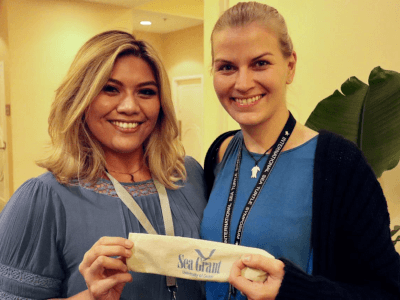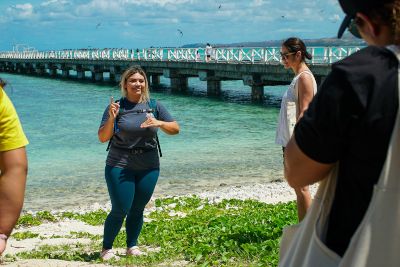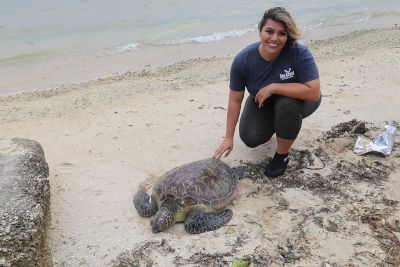UOG turtle biologist selected for National Science Foundation fellowship
UOG turtle biologist selected for National Science Foundation fellowship
UOG turtle biologist selected for National Science Foundation fellowship
4/30/2019

University of Guam Sea Grant’s resident sea turtle biologist Josefa Muñoz was selected in April to join the distinguished 2019 National Science Foundation Graduate Research Fellowship Program.
The national program recruits high-potential early-career scientists and engineers and supports their research training through a master’s or doctorate program at a U.S.-accredited institution. After an extensive review process, Muñoz was notified that she was one of 2,000 awardees selected as a fellowship recipient for 2019. More than 12,000 students typically apply.
“I still can’t wrap my head around it,” she said. “People from the science community say that once you get this, you’re set for life.”
As an NSF graduate research fellow, Muñoz will receive an annual stipend of $34,000 for three years within the five-year fellowship period along with a $12,000 cost-of-education allowance to the institution in which she enrolls.
“We’re extremely proud of Sefa and know that she will go far,” said Austin Shelton, director of UOG Sea Grant and investigator on two NSF-funded grant projects at UOG. “She is only the second UOG alum to be selected for this prestigious fellowship. We look forward to her returning home with graduate degrees and continuing to help our island.”
The first UOG student to be selected was biology major Jerilyn Calaor last year. Shelton said the Sea Grant program will continue seeking opportunities to increase its research capacity, research training for students, and benefits to the community.
A calling to help the haggan

Muñoz received her bachelor’s degree in biology from UOG’s College of Natural & Applied Sciences in May 2017. During her studies, she availed of several opportunities to take internships abroad for research projects, including studying avian bioacoustics in Costa Rica and deep-sea microbiology at the Scripps Institution of Oceanography in San Diego. But she always came back to Guam’s native green sea turtles, or haggan.
“I felt like I assumed responsibility for them,” she said. “It all started at UOG when my class got a visit from the Department of Agriculture’s sea turtle expert. She asked for volunteers for Haggan Watch, and I signed up. I learned so much about monitoring, and I just loved being around the turtles.”
As a sea turtle biologist, Muñoz spends most of her mornings at the beaches on Andersen Air Force Base for turtle monitoring and nesting excavation.
Upon verifying a nest, Muñoz conducts inventory to determine hatching success. Guam’s green sea turtle is endangered, so it is important that close monitoring is done so that potential dangers to its population are identified and mitigated, she said.
Joining a bigger current
In February, Muñoz attended the 2019 International Sea Turtle Symposium in Charleston, S.C., where she presented data on green sea turtle nesting activity on the Air Force base. She also had the opportunity to meet Christine Figgener, the sea turtle expert whose team received international acclaim after capturing footage of a sea turtle with a plastic straw stuck in its nose. The video started a worldwide movement to ban plastic straws.
“The conference was so inspiring,” she said. “Getting together with people who also work with sea turtles every day motivated me even more to pursue this field. It also made me want to stay and work on Guam. Just being there really showed me how unique Guam is.”

Inviting others to action
The other half of her job consists of extensive outreach in the community, from schools to public fairs and festivals. Muñoz gathers the information from her work and presents it to the public so that residents are aware of the ongoing conservation efforts that benefit Guam’s native species and natural resources.
“The more you know about something, the more you can help protect it,” she said.
Most recently, she delivered a presentation of her work experience as a Seed Talk at the 10th UOG Regional Conference on Island Sustainability. In a similar format to TED Talks, Muñoz shared how plastic waste on Guam is harmful to the native sea turtles and that the community should adopt sustainable habits to prevent further harm of the species. Her call to action — “pick up three, use three, and tell three” — encouraged people to be good stewards of the land by picking up trash, using reusable water bottles, bags, and cutlery, and telling others to do the same.
‘Where my heart is’
While she hasn’t made official where she plans to continue her education, she said she is excited to continue her research proposal that she submitted to NSF — understanding mating strategies and the sex ratio for green sea turtles born in Guam in the face of ongoing climate change, as warmer conditions breed more females, which could become problematic for the green sea turtle population as a whole. With her research, she hopes to establish a baseline of data for the nesting population of sea turtles on Guam so that the impacts of climate change on the species can be measured over the years.
“This is where my heart is. I want to do my research here,” she said.
